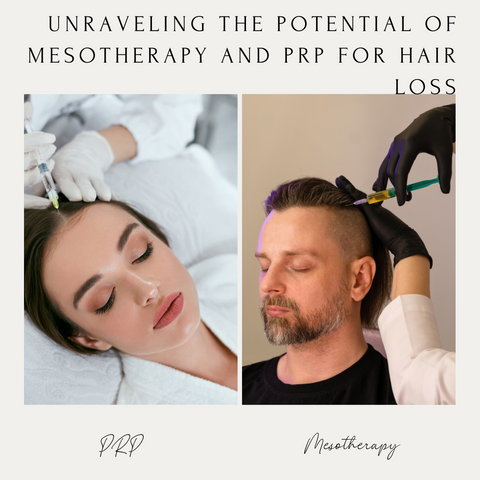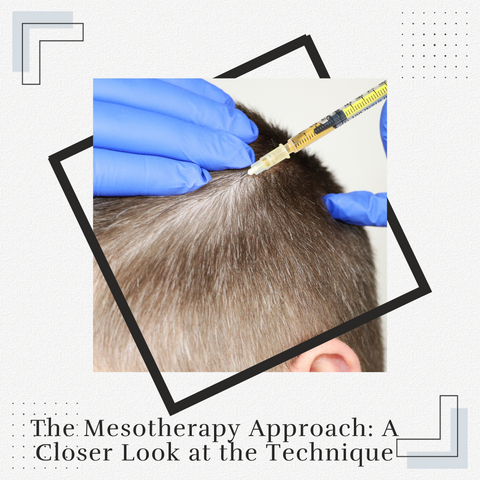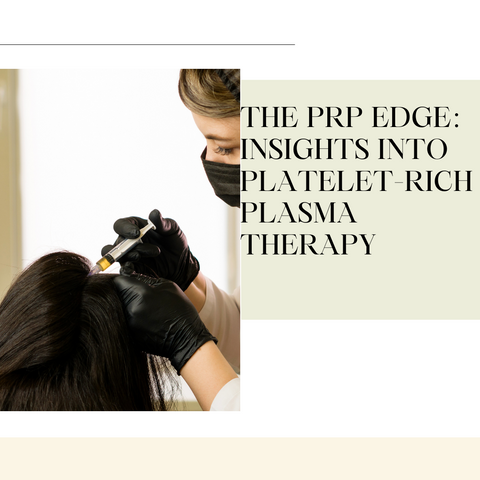Mesotherapy and Platelet-Rich Plasma (PRP) are both common therapies for hair loss, each with its own set of benefits and drawbacks. This blog is the definitive comparison of Mesotherapy vs PRP for hair regrowth.
Unraveling the Potential of Mesotherapy and PRP for Hair Loss

Mesotherapy is the injection of vitamins, minerals, amino acids, and other active ingredients directly into the scalp. Mesotherapy combinations might vary depending on the individual's demands and the practitioner's choices. The purpose is to stimulate hair follicles, increase blood circulation, and promote hair growth. Mesotherapy works for hair loss by providing nourishment, improving blood circulation, and decreasing inflammation. Both mesotherapy and PRP therapy are safe procedures with few side effects, such as moderate soreness, redness, or swelling at the injection site, but they may not be appropriate for everyone. Before beginning any hair loss treatment, always discuss your concerns and expectations with a healthcare expert.
Diving Deep into Mesotherapy: How Does it Promote Hair Growth?
Mesotherapy for hair loss entails injecting a mixture of vitamins, minerals, amino acids, and other active chemicals into the scalp. The technique is thought to promote hair growth by improving microcirculation, nutrient delivery, hormonal balancing and dht management, anti-inflammatory effects, stimulation of hair follicle activity, and hair health support. Before undergoing mesotherapy or any other hair loss treatment, it is critical to consult with a qualified healthcare professional or dermatologist who is familiar with these procedures. They can assess your condition and recommend the best treatment plan for your specific needs.
The Science of PRP: Uncovering its Role in Hair Regeneration
Platelet-high Plasma (PRP) therapy for hair regeneration includes injecting a concentrated form of the patient's blood, high in platelets and growth factors, into the scalp to encourage hair growth and thickness. The procedure uses the body's own healing powers to encourage hair regeneration through a variety of methods, including:
-
Growth Factor Stimulation: Platelet-derived growth factor (PDGF), vascular endothelial growth factor (VEGF), transforming growth factor-beta (TGF-beta), and other growth factors are abundant in PRP. These growth factors are essential for tissue healing, cell regeneration, and promoting hair follicle activity.
-
Hair Follicle Activation and Proliferation: These growth factors are thought to awaken dormant hair follicles, causing them to enter the active growth phase (anagen) and promote hair cell proliferation when injected into the scalp. Increased hair density and thickness may result from this stimulation.
-
Improved Blood Circulation: The growth factors in PRP can help enhance blood circulation in the scalp. Increased blood flow can nourish hair follicles, providing them with crucial nutrients and oxygen required for healthy hair development.
-
Anti-Inflammatory Effects: PRP may offer minor anti-inflammatory activity. Inflammation can aggravate certain types of hair loss, and reducing inflammation in the scalp may create a more favorable environment for hair follicle health and growth.
-
Collagen Production and Tissue Repair: Aside from encouraging hair growth, PRP may also aid in collagen formation and tissue healing in the scalp. This can help to strengthen the hair. While PRP therapy is usually regarded as safe with little danger of side effects (since it uses the patient's own blood), its effectiveness is dependent on a number of factors, including the underlying cause of hair loss and individual reactions to treatment.
Mesotherapy and PRP: Weighing the Pros and Cons for Hair Treatment
Mesotherapy and Platelet-Rich Plasma (PRP) therapy are both common therapies for hair loss, each with its own set of advantages and disadvantages. Understanding this can help people make more educated decisions about which treatment is best for their personal illness.
Mesotherapy for Hair Treatment:
Pros:
-
Nourishment and Better Scalp Health: The goal of mesotherapy is to directly inject a mixture of vitamins, minerals, and other nutrients into the scalp in order to nourish the hair follicles and enhance the general health of the scalp.
-
Stimulation of Blood Circulation: The injections might increase scalp blood flow, which might awaken dormant hair follicles and encourage hair development.
-
Customised Formulations: Depending on the particular hair condition, mesotherapy treatments can be customised to meet the needs of each patient by changing the nutrient combination.
Cons:
-
Requires Multiple Sessions: In most cases, multiple sessions are required to achieve noticeable results, which may add time and expense to the treatment.
-
Variable Effectiveness: Individual results can differ greatly, and not everyone may see appreciable increases in hair thickness or growth.
-
Limited Scientific Evidence: Although some studies point to advantages, there is currently little scientific proof that mesotherapy is a successful treatment for hair loss.
PRP Therapy for Hair Treatment:
Pros:
-
Natural Growth Stimulation: PRP contains growth factors that, by reawakening dormant hair follicles, may naturally stimulate hair growth and improve hair thickness.
-
Autologous and safe: PRP is produced using the patient's own blood, which lowers the possibility of rejection or allergic responses. It is usually regarded as safe and has few adverse effects.
-
Customised Treatment Plans: Depending on the patient's response to therapy and the degree of hair loss, treatment plans can be made specifically for each patient.
Cons:
-
Several Sessions and Maintenance: In line with mesotherapy, several sessions are frequently necessary to achieve noticeable outcomes. To maintain the effects, maintenance sessions might also be required.
-
Variable Results: While many people experience improvement, results vary, and not everyone experiences significant hair regrowth or thickening.
-
Cost Considerations: PRP therapy is relatively expensive due to the multiple sessions required, which may not be feasible for everyone.
Finally, when considering mesotherapy or PRP therapy for hair loss, it is critical to weigh the pros, cons, cost, and individual suitability in order to make an informed decision about the best treatment option.
The Mesotherapy Approach: A Closer Look at the Technique

Mesotherapy is a minimally invasive treatment for a variety of problems, including hair loss. Mesotherapy is used to treat hair loss by injecting a customised blend of vitamins, minerals, amino acids, and other active chemicals directly into the scalp. Consultation and evaluation, customised formulation, preparation and administration, treatment sessions, and post-treatment care are all steps in mesotherapy for hair loss.
Mesotherapy Helps Hair Growth:
-
Direct Nutrient Delivery: The injected nutrient blend is designed to directly nourish hair follicles, providing essential vitamins, minerals, and amino acids for healthier hair growth.
- Improved Scalp Circulation: Some formulations may contain ingredients that increase blood circulation in the scalp, thereby increasing oxygen and nutrient delivery to hair follicles.
-
Dormant Follicle Stimulation: The injections' micro-injuries, in combination with the nutrient-rich fluid, may stimulate dormant or weaker hair follicles, causing them to enter the growth phase.
Before undergoing mesotherapy for hair loss, it is critical to consult with a qualified healthcare professional or dermatologist who is familiar with this technique. They can evaluate the treatment's suitability based on your specific condition and recommend an appropriate treatment plan.
Understanding the Mechanism of Mesotherapy for Hair Revival
Mesotherapy for hair restoration is a multifaceted approach that aims to improve hair health and stimulate hair growth. The technique works through a number of mechanisms to rejuvenate the scalp and promote healthier hair follicles:
-
Direct Nutrient Infusion: Mesotherapy involves directly injecting a tailored blend of vitamins, minerals, amino acids, and other active components into the scalp. This infusion contains Biotin, B Vitamins, Minerals (e.g., zinc, magnesium), and Amino Acids, which are vital elements for hair development and follicle health.
-
Enhanced Blood Circulation: Vasodilators, or chemicals that enhance blood circulation in the scalp, are used in several mesotherapy formulations. This increased blood flow ensures that more oxygen, nutrients, and growth factors are delivered to the hair follicles, resulting in improved oxygenation and enhanced nutrient availability.
-
Activation of Dormant Follicles: Mesotherapy's microinjections may cause microtrauma, reactivating dormant or weaker hair follicles. This stimulation causes these follicles to enter the active growth phase (anagen phase), which promotes hair growth.
-
Anti-Inflammatory Effects: Anti-inflammatory drugs are present in several mesotherapy solutions. Inflammation can harm hair follicles, thus lowering inflammation in the scalp may help to produce a more favourable environment for hair growth. Reduced scalp irritation can help prevent hair follicle damage and offer a better environment for hair growth.
-
Support for Scalp Health: Mesotherapy seeks to improve overall scalp health as well as hair follicle health, creating a more favorable environment for healthy hair development. Improved scalp health can lead to improved hair growth and condition.
Effectiveness and Considerations:
-
Treatment Regimen: Typically, multiple sessions are required to produce visible benefits. The number and frequency of sessions may vary depending on individual reactions and the severity of hair loss.
-
Consultation with Professionals: It is important to consult with a trained healthcare practitioner or dermatologist who is experienced in mesotherapy to diagnose your condition and establish a suitable treatment plan.
-
Individual Response: Individual responses vary, and not everyone will see significant improvements in hair growth.
What to Expect: The Mesotherapy Treatment Experience
Mesotherapy for hair loss entails a number of stages and concerns. Individuals can prepare for the therapy by knowing what to expect before, during, and after it.
Before Beginning Treatment:
-
Consultation: It is important to speak with a certified healthcare expert or dermatologist. They evaluate your hair loss situation and medical history to determine if mesotherapy is right for you. The practitioner goes over the treatment plan, your expectations, and any issues or questions you may have.
-
Preparation: Before the treatment session, wash your hair with a gentle shampoo. Avoid using any styling products or applying hair treatments on the day of the procedure.
Throughout the Treatment:
-
Preparation of Solution: The practitioner creates a solution for you that includes vitamins, minerals, amino acids, and other active substances that are particular to your situation.
-
Procedure: Before the process, the scalp is carefully washed. Although certain formulations contain anaesthetic characteristics, local anaesthesia may be used to reduce discomfort during injections. The practitioner injects the customised solution straight into the scalp with a small needle, focusing on areas afflicted by hair loss or thinning. In most cases, the injections are given in a grid-like pattern across the scalp.
-
Duration: A mesotherapy session normally lasts 20 to 30 minutes, however, this might vary depending on the size of the treated region and the practitioner's expertise.
Following the Treatment:
-
Following the procedure, mild redness, swelling, or minor discomfort at the injection sites is possible. These effects typically fade after a short period of time. Your healthcare provider may give you instructions about specific after-treatment care, such as refraining from using certain items or activities for a period of time after the session.
-
Mesotherapy usually necessitates a series of sessions spaced several weeks apart in order to produce noticeable results. The number of sessions required will be determined by the individual's response and the extent of hair loss.
-
Consultations with your healthcare provider are essential for tracking progress, evaluating treatment efficacy, and determining the need for additional sessions.
Before beginning mesotherapy, it is critical to discuss any concerns or expectations with your healthcare provider. They can give you detailed information about what to expect and make personalised recommendations for your specific condition.
Evaluating the Efficacy: Mesotherapy Success Stories
Mesotherapy for hair loss has received mixed reviews in terms of efficacy, and individual results may vary. While some people report excellent results and attribute improvements in hair growth and thickness to mesotherapy, others may not notice major changes such as improved hair density, improved hair quality, reduced hair loss, satisfaction with results, and the benefits of combination therapy.
Factors Affecting Efficacy and Considerations:
-
Individual Response: Individual responses to mesotherapy can vary greatly. The effectiveness of the therapy can be influenced by factors such as the underlying cause of hair loss, overall health, genetics, and adherence to treatment protocols.
-
Hair Loss Severity: Mesotherapy may be more effective for certain types of hair loss or in the early stages of hair thinning than in advanced cases of baldness.
-
Treatment Regimen: Following through on multiple sessions as recommended by a healthcare professional is critical for achieving potential positive outcomes.
-
Combination Therapies: Combining mesotherapy with other complementary therapies may produce better results for some people.
-
Expectations: It is critical to have realistic expectations about the outcomes of mesotherapy. It may not completely restore lost hair, but it may improve hair quality and slow further hair loss.
While some people share success stories about mesotherapy for hair loss, it's important to approach any treatment with realistic expectations and get personalised guidance from a healthcare practitioner. Mesotherapy efficacy varies, and results may not be consistent across all individuals.
The PRP Edge: Insights into Platelet-Rich Plasma Therapy

Platelet-Rich Plasma (PRP) therapy is a treatment that has gained attention for its potential to stimulate hair growth and improve hair health. Here are insights into PRP therapy:
-
Process of PRP Therapy: Similarly to a regular blood test, a small amount of the patient's blood is collected, usually from the arm. The blood sample is placed in a centrifuge, a machine that spins rapidly, separating the blood components. This procedure separates platelet-rich plasma from other blood components. The concentrated plasma is removed for use in the treatment because it is high in platelets and growth factors.
-
Mechanism of Action: Platelets, which produce growth factors such as platelet-derived growth factor (PDGF), vascular endothelial growth factor (VEGF), and others, are prevalent in PRP. These growth factors can be injected into the scalp to promote hair thickness and growth by activating dormant hair follicles, increasing cell proliferation, and promoting tissue healing.
-
Application in Hair Restoration: Using fine needles, the concentrated PRP solution is injected into the scalp at the level of the hair follicles. The injections are deliberately administered in regions of hair loss or thinning. Multiple therapy sessions, spaced several weeks apart, are usually needed to attain the best outcomes. Maintenance sessions may be recommended to keep the effects going.
-
Effectiveness and Considerations: Individual responses to PRP therapy differ. Some people see a substantial improvement in hair density and thickness, while others may notice just minor changes. PRP therapy may be more effective than other forms of alopecia for some types of hair loss, such as androgenic alopecia (male/female pattern baldness). Combining PRP therapy with other therapies, such as mesotherapy or topical medicines, such as minoxidil, may improve outcomes in some patients. PRP therapy is generally thought to be safe because it uses the patient's own blood, which lowers the chance of allergic reactions or rejection.
-
Consultation and Professional Advice: It is important to consult with a certified healthcare expert or dermatologist who is familiar with PRP therapy for hair loss. They can diagnose your illness and recommend the best treatment strategy for you based on your specific needs. It is critical to have reasonable expectations about the outcomes of PRP therapy. It may not result in complete hair regrowth, but it may enhance hair quality and reduce additional hair loss.
PRP Therapy Demystified: A Step-by-Step Guide to the Procedure
Here's a step-by-step guide to Platelet-Rich Plasma (PRP) therapy, including the initial consultation, preparation for PRP therapy, centrifugation process, platelet concentration, administration of PRP therapy, post-treatment care, and treatment schedule.
Taking into account:
-
Consultation with Experts: It is essential to have a consultation with a licenced healthcare provider who has knowledge of PRP therapy for hair loss. They are able to assess your condition and make recommendations for a suitable, individualised treatment plan.
-
Realistic Expectations: While PRP therapy might not completely restore lost hair, it may help some people's hair quality, slow down their rate of hair loss, and stimulate the growth of new hair.
This is a step-by-step guide that outlines the PRP therapy process for hair loss. Each stage is critical to ensuring the treatment's safety and efficacy. Consultation with a healthcare professional before and after the procedure is essential for personalised guidance and results monitoring.
Real Results: Examining PRP’s Effectiveness in Hair Restoration
In some cases, Platelet-Rich Plasma (PRP) therapy for hair restoration has shown encouraging effects in accelerating hair growth and enhancing hair quality. However, the success of PRP therapy might vary depending on a number of factors, including:
-
Study Findings and Evidence: Some studies suggest that PRP therapy can improve hair density, thickness and reduce hair loss in those with specific kinds of alopecia, including androgenetic alopecia (male/female pattern baldness). PRP therapy has been shown in research studies and clinical trials to promote hair growth and improve hair quality. More thorough and rigorous research, however, is required to confirm its efficacy across all types and stages of hair loss.
-
Individual Response: Individual responses to PRP therapy can vary greatly. The severity and cause of hair loss, genetics, overall health, and adherence to treatment regimens can all have an impact on the outcome. PRP therapy may be more effective than other forms of alopecia for specific types of hair loss, including androgenetic alopecia.
-
Treatment Schedule and Consistency: To acquire visible benefits from PRP therapy, many treatment sessions spaced several weeks apart are usually required. Maintaining consistency in attending the prescribed sessions is essential for potential positive outcomes. Maintenance sessions may be recommended to keep the effects going.
-
Combination Therapy: PRP therapy can sometimes be used in conjunction with finasteride, minoxidil, or mesotherapy to produce better results for certain patients.
-
Realistic Expectations: It is possible that PRP treatment will not fully restore lost hair. Improving hair quality, halting additional hair loss, and possibly encouraging new hair growth in specific areas are frequently its main objectives.
While PRP therapy appears to be a promising non-invasive option for hair regeneration, its effectiveness is dependent on a variety of circumstances, and not everyone will see significant gains. A personalised evaluation and consultation with a healthcare specialist are required to determine whether PRP therapy is a viable choice for resolving your hair loss concerns.
Beyond the Treatment: Post-PRP Care for Optimal Outcomes
Post-PRP maintenance is critical for achieving the best results and reaping the full benefits of Platelet-Rich Plasma (PRP) therapy for hair restoration. Following PRP therapy, the following are some important considerations and care instructions to follow:
-
Avoid Touching or Washing the Scalp Right Away: After treatment, refrain from touching or scratching the treated areas to prevent infection or irritation. Wash your hair at least 24 to 48 hours after the treatment to allow the PRP to be efficiently absorbed into the scalp.
-
Gentle Hair Care Routine: Whenever washing your hair after the specified waiting period, use a gentle, sulfate-free shampoo. Avoid using strong shampoos that may hurt your scalp. Avoid using hot styling equipment, harsh chemicals, tight hairstyles, or frequent brushing, which can cause scalp discomfort.
-
Sun Protection: For a few days after the treatment, avoid direct sun exposure on the scalp. Consider wearing a hat or using sunscreen designed specifically for the scalp to protect it from damaging UV radiation.
-
Follow Post-Treatment Instructions: Follow any special post-treatment recommendations given to you by your healthcare provider. Avoiding certain activities, treatments, or goods that may interfere with the healing process is one of these guidelines.
-
Maintain a Healthy Lifestyle: Maintain a healthy diet rich in nutrients, such as proteins, vitamins, and minerals, which are necessary for hair health and growth. Drink plenty of water to stay hydrated, as hydration is important for general skin and hair health.
-
Frequent Follow-Ups: You should plan your follow-up visits in accordance with your healthcare provider's instructions. These meetings are essential for monitoring progress, evaluating results, and determining whether additional treatments or maintenance sessions are required.
-
Be Patient and Control Your Expectations: Acknowledge that it might take some time for PRP therapy to show results. Hair growth and quality improvements are gradual processes, and individual responses may differ.
-
Consider Lifestyle Modifications: If lifestyle factors, such as stress or certain habits, contribute to hair loss, consider making appropriate changes to minimise their impact on hair health.
By adhering to these post-PRP care instructions, you can enhance the treatment's results and promote healthy hair growth. Following advised care instructions helps to create an environment that is conducive to hair restoration and general scalp health.
Conclusion: Making the Informed Decision for Your Hair Loss Journey

Making an informed decision about hair loss treatment entails taking into account many criteria and comprehending the available solutions. You may make an informed decision about your hair loss journey by properly evaluating treatment alternatives, considering individual requirements and expectations, and talking with a healthcare expert. Remember that personalised coaching and a realistic approach are critical to attaining the best results.









































